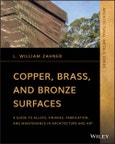Copper, Brass, and Bronze Surfaces, third in Zahner's Architectural Metals Series, provides a comprehensive and authoritative treatment of copper, brass, and bronze applications in architecture and art. If offers architecture and design professionals the information they need to ensure proper maintenance and fabrication techniques through detailed information and full-color images. It covers everything from the history of the metals and choosing the right alloy, to detailed information on a variety of surface and chemical finishes and corrosion resistance. The book also features case studies that offer strategies for designing and executing successful projects using copper, brass, and bronze.
Copper, Brass, and Bronze Surfaces is filled with illustrated case studies that present comprehensive coverage of how each metal is used in creating surfaces for building exteriors, interiors, and art finishes. All the books in Zahner's Architectural Metals Series offer in-depth coverage of today's most commonly used metals in architecture and art. This visual guide: - Features full-color images of a variety of copper, brass, and bronze finishes, colors, textures, and forms - Includes case studies with performance data that feature strategies on how to design and execute successful projects using copper, brass, and bronze - Offers methods to address corrosion, before and after it occurs - Explains the significance of the different alloys and the forms available to the designer - Discusses what to expect when using copper, brass, and bronze in various exposures
Written for architecture professionals, metal fabricators and developers, architecture students, designers, and artists working with metals, Copper, Brass, and Bronze Surfaces offers a logical framework for the selection and application of copper, brass, and bronze in all aspects of architecture.
Table of Contents
Preface xi
Chapter 1 Introduction - Element 29 1
Introduction 1
Color 6
Colors of Alloys 8
Copper Minerals 12
History 13
The Modern Copper Production Process 19
Sustainability, Environmental, and Hygienic Concerns 22
Copper and Water 23
Health and Safety 24
Copper: The Antimicrobial Metal 25
Copper Alloys for the Arts 26
Chapter 2 Copper and Its Alloys 31
Introduction 31
The Rich History of Copper Alloys 31
Elements Added to Copper 33
Alloy Designation System 34
The Unified Numbering System 34
Tempers 36
Wrought Copper Alloys 38
Brasses 40
Leaded Brasses 49
Tin Brasses 54
Phosphor-Bronze Alloys 56
Aluminum-Bronze Alloys 58
Silicon-Bronze Alloys 60
Copper-Nickel and Nickel-Silver Alloys 61
Cast Alloys 66
Red Brasses 69
Yellow Brasses 71
Silicon-Bronze Alloys 73
A Tin-Bronze Alloy 76
Nickel-Silver Alloys 77
A Manganese-Bronze Alloy 78
Chapter 3 Surface Finishes 79
Introduction 79
Mill Surfaces 80
Mechanical Finishes and Temporary Protection 81
Color from Oxidation and Chemical Reactions 91
Textures 123
Tin-Coated Copper 135
Melted Copper Alloy Surfacing 136
Copper and Glass 137
Protecting the Surface 138
Chapter 4 Expectations of the Visual Surface 139
Introduction 139
Intent: An Unchanged Surface Appearance 143
Intent: A Surface Appearance That Changes Naturally 154
Flatness 155
Texturing the Surface 160
Initial Oxidation on Copper Alloys 161
In Situ Patination 163
Prepatination 164
The Effect of Sealants 166
The Cast Surface 167
Arriving at the Best Possible Outcome 167
Chapter 5 Designing with the Available Forms 173
A Brief History 173
Wrought Forms 176
The Cast Form 204
Chapter 6 Fabrication Processes and Techniques 211
Introduction 211
Forming 213
V-cutting 215
Cutting Copper Alloys 220
Machining 227
Soldering, Brazing, and Welding 231
Casting 241
Chapter 7 Corrosion Characteristics 251
General Information 251
Categories of Corrosion 260
Environmental Exposures 279
Acids and Bases 283
Copper Alloy Surface Categories 286
Chapter 8 Maintaining the Copper Alloy Surface 295
Introduction 295
Protecting the New Copper Alloy Surface 296
Achieving Physical Cleanliness 296
Achieving Chemical Cleanliness 311
Achieving Mechanical Cleanliness 320
Repairing Patinas 326
Protecting the Surfaces of Copper and Copper Alloys 328
Cleaning the Copper Surface 333
Removing Copper Stains from Other Substances 334
Deteriorating Patinas 335
Appendix A Comparative Attributes of Metals Used in Art and Architecture 337
Appendix B Hardware Finish Codes and Descriptions 341
Appendix C Numbering Systems Used for Copper Alloys 345
Further Reading 347
Index 349








